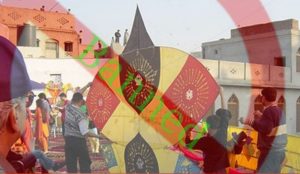
History of the Ban of Basant in Pakistan
History of the Ban of Basant in Pakistan is a story of grievance. The event of ‘Basant’ is a historic spring festival in Punjab. Amritsar, Lahore, and Kasur were the traditional areas where kite flying festivals were held. Before the year 1999, Basant used to be celebrated without intervention of the state and was governed through unregulated bodies which were driven by centuries old cultural forces prevalent in the region. In the year 1999 when sanctions were imposed on Pakistan due to atomic explosions, Basant was portrayed by the Government of Pakistan as a cultural event to project the soft image of Pakistan. 
The event of Basant was boosted when the Government started projecting the event. As a result a lot of multinationals started celebrating the event on state level. The event started attracting the flow of money which resulted in manufacturing and flying of big kites and as a consequence the manufacturers of the kite thread i.e. ‘doar’ started making strong and unbreakable threads.
It is very comic that while projecting the Basant for its own material gains, the Government never envisaged the aftereffects of such projections and did not bother to make any rules, regulations or code of conduct for the event. The absence of any regulation made two fold effects over activity of kite flying. The first thing was the strengthening of kite flying thread which became stronger than the traditional thread used for making ‘doar’. The second affect was the change in procedure for making and applying powdered glass coated on the thread i.e. “Manja”. The procedure was changed by adding additional chemicals and better quality of the glass which enhanced the cutting capacity of Manja. As a result, the stray kite strings became vulnerable for public specifically motorcyclist. The strong doars with sharp Manja started injuring people frequently and precious lives had been lost. The increased strength of the ‘doar’ also affected the electricity systems of the city.
Due to increased injuries caused by stray kite strings the Supreme Court of Pakistan took a suo moto notice back in year 2005 and directed the Government to regularize the activities of kite flying and make proper code of conduct. Needless to say that the event became bloody due to the negligence and lack of far sightedness of the Government. The then Government, instead of regularizing the event, preferred to put a complete ban on the trade and activity while violating the fundamental right and Article 18 of the Constitution of Pakistan. 
The kite flying activities were further tried to be regulated at a subsequent stage vide Punjab Kite Flying (Amendment) Ordinance, 2007 (XX of 2007) followed by The Punjab Kite Flying Rules, 2007. The Ordinance of 2007 was subsequently repealed by Punjab Prohibition of Kite Flying (Amendment) Act, 2009 whereby the Punjab Prohibition of Dangerous Kite Flying Activities Ordinance, 2001 (LIX of 2001) was amended. The aforesaid legislation laid down the rules for making kites, thread i.e. (‘doar’) and ‘manja’. The rules also provided for opening the festival during a certain period for a particular point of time in a year. The above legislation had its own defects and shortfalls and was in itself against the spirit of fundamental rights granted under the Constitution of Pakistan.
The spirit of the above discussed judgement of Supreme Court of Pakistan and the subsequent legislation was thrown to winds by the Provincial Government by disallowing the Basant Festival due to inefficient working systems of the Provincial Government and unwillingness of the Provincial Government to enforce the writ of the state.
Also Read
Defect in Kite Flying Laws and Improvements Required
https://khalidzafar.com/kite-flying-laws-the-defects- and-improvements
Role of District Kite Flying Association in killing the culture of kite flying in Lahore
https://khalidzafar.com/killing-the-culture- and-death-of-art-by-district-kite-flying-association
Effect of the Ban on livelihood of workers
https://khalidzafar.com/effect-of-ban-on-basant-kite-flying-activities-on-livelihoods-of-kite-makers- and-home-based-workers